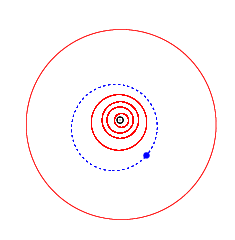Top Qs
Timeline
Chat
Perspective
(9948) 1990 QB2
Stony Nysian asteroid From Wikipedia, the free encyclopedia
Remove ads
(9948) 1990 QB2 (provisional designation 1990 QB2) is a stony Nysian asteroid from the inner region of the asteroid belt, approximately 3.4 kilometers (2.1 miles) in diameter. It was discovered on 22 August 1990, by American astronomer Henry Holt at the Palomar Observatory in California.[1] The likely elongated S-type asteroid has a rotation period of 3.53 hours.[3] This asteroid has not been named.[1]
Remove ads
Orbit and classification
1990 QB2 is member of the Nysa family (405),[4] located in the Nysa–Polana complex. It is named after 44 Nysa and one of the largest families in the main belt.[13]: 23
The asteroid orbits the Sun in the inner asteroid belt at a distance of 1.9–2.9 AU once every 3 years and 8 months (1,344 days; semi-major axis of 2.38 AU). Its orbit has an eccentricity of 0.22 and an inclination of 2° with respect to the ecliptic.[2] The asteroid was first observed as 1979 SJ6 at Crimea–Nauchnij in September 1979. The body's observation arc begins at Palomar with its official discovery observation in 1990.[1]
Remove ads
Physical characteristics
1990 QB2 has been characterized as a common, stony S-type asteroid by Pan-STARRS' survey and in the SDSS-based taxonomy.[3][11][12]
Rotation period
In November 2005, a first rotational lightcurve of 1990 QB2 was obtained from photometric observations by Australian amateur astronomer David Higgins. Lightcurve analysis gave a well-defined rotation period of 3.5257 hours with a high brightness variation of 0.77 magnitude (U=3).[9] In January 2014, observations in the R-band at the Palomar Transient Factory in California gave two concurring periods of 3.523 and 3.53 hours with an amplitude of 0.60 magnitude (U=2/2).[8][10] A high brightness amplitude typically indicates that the body has a non-spherical shape
Diameter and albedo
According to the survey carried out by the NEOWISE mission of NASA's Wide-field Infrared Survey Explorer, 1990 QB2 measures 3.345 kilometers in diameter and its surface has an albedo of 0.250.[5][6] The Collaborative Asteroid Lightcurve Link adopts Petr Pravec's revised WISE-result, that is, an albedo of 0.2232 and a diameter of 3.351 kilometers based on an absolute magnitude of 14.62.[3][7]
Remove ads
Naming
This minor planet was numbered on 2 February 1999 (M.P.C. 33659).[14] As of 2018, it has not been named.[1]
References
External links
Wikiwand - on
Seamless Wikipedia browsing. On steroids.
Remove ads

